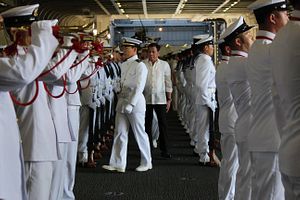Philippine President Rodrigo Duterte became the first head of state to tour Japan’s largest warship, the Japan Maritime Self-Defense Force (JMSDF) helicopter carrier JS Izumo, the lead vessel of the new 27,000-ton Izumo-class, in Subic Bay, located on the west coast of the island of Luzon in the Philippines, on June 4.
The JS Izumo and the guided-missile and antisubmarine warfare (ASW) Takanami-class destroyer JS Sazanami are currently in the Philippines for a four-day goodwill visit following their participation in this year’s U.S.-led Pacific Partnership (PP17) mission, the largest annual multilateral humanitarian assistance and disaster relief (HA/DR) preparedness exercise conducted in the Asia-Pacific region.
Upon arrival at the flight deck of the JS Izumo, the Philippine president was accorded a JMSDF guard of honor and welcomed by Katsuyuki Kawai, Special Advisor to Japanese Prime Minister Shinzo Abe; Admiral Yamamura, Vice Chief of Staff for Defense Plans and Policy at the Joint Staff at the Japan Ministry of Defense; and the JMSDF Escort Flotilla One Commander Rear Admiral Yoshihiro Goka, next to other senior Japanese officials.
Following a briefing on the ship’s capabilities, Duterte visited several areas including medical facilities and the ship’s command center. According to a Japanese Ministry of Defense press statement, while touring the Izumo Kawai emphasized “that Japan hopes to strengthen the defense cooperation in Maritime Security with Philippine with the recognition that both Japan and Philippine are maritime states and all national interests derive from the sea.”
In return, the Philippine president “appreciated the great experience aboard Izumo and highly commended superior HA/DR ability of Izumo,” the statement reads. “President Duterte also commented that Philippine is willing to deepen the defense cooperation with Japan,”according to the Philippine Star. Furthermore Duterte emphasized the “historical friendship” between the two countries and promised to be an ally “for all time.”
According to a Philippine Navy press statement, the four-day visit of JMSDF Escort Flotilla One “seeks to enhance the already strong relationship between the Philippine Navy (PN) and JMSDF. It will also further sustain promotion of peace, stability, and maritime cooperation between the two countries through naval diplomacy and camaraderie.” Over the next few days, both navies will participate in ship visits, joint receptions, and hold several sports events, among a host of other activities.
Earlier this year, the Philippine president has visited Chinese and Russian warships anchored in Philippine ports. However, when the Nimitz-class aircraft carrier USS Carl Vinson visited the Philippines in May, Duterte merely sent three cabinet secretaries to tour the ship, which some analysts interpreted as a deliberate snub to the United States and a gesture of goodwill towards China. Nevertheless, Duterte’s tour of the Izumo on June 4 is sure to draw some critical comments from Beijing given that China sees the new warship as alarming evidence for Japan’s growing offensive military capabilities.
Furthermore, Chinese state-owned media has repeatedly pointed out that the Izumo’s bears the “same name as the flagship of the Japanese fleet that invaded China in the 1930s.” and that the deployment of the new carrier, “is yet another ‘edge ball’ played by the Japanese government… China can only respond to Izumo, this light aircraft carrier dressed as an ‘escort vessel’, by developing a real aircraft carrier,” as the Global Times stressed in a commentary. As I explained previously:
The Japanese Navy officially classifies the Izumo-class as helicopter destroyers [and escort ship] in order to downplay the warship’s offensive capabilities. (…) The ship is designed to accommodate up to 14 helicopters (seven Mitsubishi-built SH-60k ASW helicopters and seven Agusta Westland MCM-101 mine countermeasure helicopters), five of which can simultaneously take off and land, given the Izumo’s large flight deck and five landing spots.
In addition, the JS Izumo and JS Sazanami participated in a naval exercise with a U.S. Navy Independence-class Littoral Combat Ship (LCS) in the South China Sea in May. Depite Duterte’s desire for warmer ties with China, Japan has maintained close relations with the Philippines and, among other things, offered Manila patrol vessels and maritime surveillance aircraft. Both countries also signed an agreement on defense equipment and technology transfer in 2016.

































